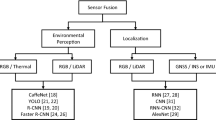Abstract
The work presented in this paper is an investigation of the prediction of amplitudes of the specific grinding force components. An improved method for artificial neural networks (ANNs) establishment is proposed here allowing accurate prediction of specific normal and tangential grinding forces. This method can determine the optimal set of inputs to be used for these ANN. This set of inputs is composed of significant factors and interactions among factors that could possibility offer the best learning and generalization of ANNs simultaneously. A 48-run experimental design (MED) is used in this research to train the ANNs and a total of 81 experiments are conducted to test the generalization performances of ANNs. Results have indicated that the developed ANNs show low deviations from the training data, and acceptable deviations from the testing data. In addition, the accuracies of these ANNs are found to be significantly better than those of other approaches used for modelling of the specific grinding force components. These approaches use regression models, power models, genetic algorithms or the common ANNs for which only factors of the MED are usually used in the input layer.
Similar content being viewed by others
References
Li ZC, Lin B, Xu YS, Hu J (2002) Experimental studies on grinding forces and force ratio of the unsteady-state grinding technique. J of Mater Process Technol 129:76–80
Malkin S (1989) Grinding technology theory and applications of machining with abrasives. Ellis Horwood Ltd., Chichester
König W, Steffens K (1982) A numerical method to describe the kinematics of grinding. CIRP Ann 31(1):201–204
Steffens K, König W (1983) Close loop simulation of grinding. CIRP Ann 32(1):255–258
Tönshoff HK, Peters J, Inasaki I, Paul T (1992) Modelling and simulation of grinding process. CIRP Ann 41(2):677–688
Brinksmeier E, Tönshoff HK, Inasaki I, Peddinghauss J (1993) Basic parameters in grinding report on a cooperative work in STC «G». CIRP Ann 42(2):795–799
Thomas M, Beauchamp Y, Youssef YA (1997) An experimental design for surface roughness and built-up edge formation in lathe dry turning. Int J Qual Sci 2(3):167–180
Youssef YA (1994) Comparison of a full factorial experiment to fractional and Taguchi design in a lathe dry turning operation. Comput Ind Eng 27(1–4):59–62
Tsai KM, Wang P-J (2001) Semi-empirical model of surface finish on electrical discharge machining. Int J Mach Tools Manuf 41:1455–1477
Lin JL, Wang KS, Yan BH, Tarng YS (2000) Optimization of the electrical discharge machining process based on the Taguchi method with fuzzy logics. J Mater Process Technol 102:48–55
Ali Y, Zhang LC (1997) Estimation of residual stress induced by grinding using a fuzzy logic approach. J Mater Process Technol 63:875–880
Rao KGRK, Kuppuswamy G (1997) Fuzzy logic interface application to the electro-chemical grinding process analysis. Proc 17th AIMTDR Conf REC Warangal:329–334
Nandi AK, Pratihar DK (2004) Design of a genetic-fuzzy system to predict surface finish and power requirement in grinding. Fuzzy Sets Syst 148(3):487–504
Saravanan R, Sachithanandam M (2001) Genetic algorithm (GA) for multivariable surface grinding process optimisation using a multi-objective function model. Int J Adv Manuf Technol 17:330–338
Gopal AV, Rao PV (2003) The optimisation of the grinding of silicon carbide with diamond wheels using genetic algorithms. Int J Adv Manuf Technol 22:475–480
Saravanan R, Asokan P, Sachidanandam M (2002) A multi-objective genetic algorithm (GA) approach fro optimization of surface grinding operations. Int J Mach Tools Manuf 42:1327–1334
Shunmugam MS, Reddy SVB, Narendran TT (2000) Selection of optimal conditions in multi-pass face-milling using a genetic algorithm. Int J Mach Tools Manuf 40:401–414
Tsai YH, Chen JC, Lou S-J (1999) An in-process surface recognition system based on neural networks in end milling cutting operations. Int J Mach Tools Manuf 39:583–605
Zouaghi N, Ichida Y, Ben Fredj N, Kimura N (1996) Grinding mode identification of silicon carbide by using neural network. In: Proceeding of the third international conference on progress of cutting and grinding Vol. III (JSPE, Osaka,) 342–347
Sakakura M, Inasaki I (1991) A neural network approach to the decision-making process for grinding operation. CIRP Ann 41(1):353–356
Kim DH, Kim DJ, Kim B (1999) The application of neural networks and statistical methods to process design in metal forming. Int J Adv Manuf Technol 15:886–894
Bishop CM (1995) Neural networks for pattern recognition. Oxford University Press, Oxford UK
Montgomery DC (1992) Design and analysis of experiments, 3rd edn. John Wiley & son, New York
Ben Fredj N, Amamou R (2006) Ground surface roughness prediction based upon experimental design and neural network models. Int J Adv Manuf Technol 31:24–36
Cus F, Balic J (2003) Optimization of cutting process by GA approach. Robot Comput Integr Manuf 19:113–121
Haykin S (1999) Neural networks a comprehensive foundation. Prentice Hall Inc., Upper Saddle River New Jersy
Heo JS, Koo Y, Choi SS (2004) Grinding characteristics of conventional and ELID methods in difficult-to-cut and hardened brittle material. J Mat Process Technol 155–156:1196–1200
Andrew C, Howes TD, Pearce TRA (1985) Creep feed grinding. Hotlt, Rinehart and Winston Ltd. Eastbourne East Sussex
Tangy JC (1985) Rectification connaissances de base et données pratiques. Centre Technique des Industries Mécaniques
Snoeys R, Peters J (1974) The significance of the chip thickness in grinding. CIRP Ann 23(2):227–237
Author information
Authors and Affiliations
Corresponding author
Rights and permissions
About this article
Cite this article
Amamou, R., Ben Fredj, N. & Fnaiech, F. Improved method for grinding force prediction based on neural network. Int J Adv Manuf Technol 39, 656–668 (2008). https://doi.org/10.1007/s00170-007-1264-9
Received:
Accepted:
Published:
Issue Date:
DOI: https://doi.org/10.1007/s00170-007-1264-9




